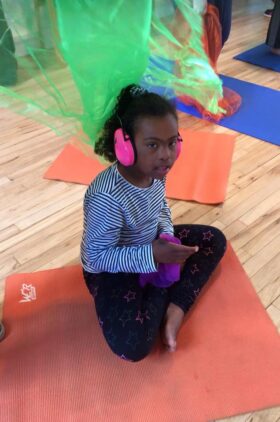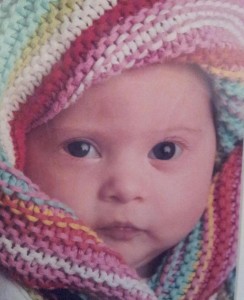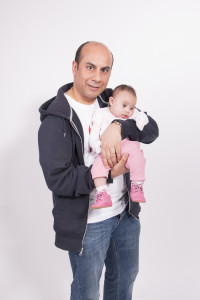What is Down syndrome? How does it happen? And 31 facts!

This section provides information about Down syndrome. It also explains some of the terms you may hear being used by professionals you meet.
Down syndrome is a characteristic group of symptoms or features that often appear in combination with one another.
In 1866 an English doctor, John Langdon Down, described a group of people who shared a consistent pattern of characteristics. The syndrome was named after him because he discovered it and it is now called Down syndrome or Down’s syndrome.
Down syndrome is a genetic condition that results in some level of learning disability and a characteristic range of physical features. Learning disability significantly affects a child’s ability to learn compared with other children of their age – it does not mean a child cannot learn at all. Down syndrome is one of the most common causes of a learning disability.
What causes the syndrome?
The human body is made up of cells. Each cell is like a factory, which has everything needed for growth and to maintain the body. Every cell contain a nucleus in which genes are stored. Genes are grouped in thread-like structures called chromosomes. Usually, the nucleus of each cell contains 23 pairs of chromosomes. Twenty-three are inherited from the mother and 23 from the father. This makes 46 chromosomes in all.
In people with Down syndrome, all or some of the cells in their bodies contain 47 chromosomes, as there is an extra copy of chromosome 21. This additional genetic material results in a range of physical and developmental characteristics associated with Down syndrome.
Let our members tell you all about it!
Three types of genetic variation are relevant:
- Trisonomy 21 – in which all the cells of the body have an extra chromosome 21. About 94% of people with Down syndrome have this type.
- Translocation – in which extra chromosome 21 material is attached to another chromosome. Around 4% of people with Down syndrome have this type.
- Mosaic – in which only some of the cells have extra chromosome 21 material. About 2% of people with Down syndrome have this type.
The type of genetic variation that children experience does not significantly alter the effect of Down syndrome. However, individuals with mosaic Down syndrome appear to experience less delay with some aspects of their development.
 Anyone can have a baby with Down syndrome.
Anyone can have a baby with Down syndrome.
Down syndrome affects people in all races, religions and economic backgrounds and in all countries around the world. It can happen to anyone.
Although the chance of having a baby with Down syndrome increases with the mothers age, babies with the syndrome are born to mothers of all ages. Over half of children born with Down syndrome are born to mothers under the age of 35 years.
As yet, no one knows what causes the presence of the extra chromosome 21. It can come from the mother or the father. There is no way of predicting whether a person is more or less likely to make an egg or sperm with an extra chromosome. What we do know is that no one is to blame. As far as we know, nothing done before or during pregnancy causes the syndrome.
Finding out.
In some cases, babies born with Down syndrome are identified before birth as a result of antenatal tests (either amniocentesis or chronic villus sampling). In most cases however, the presence of the syndrome is indicated soon after birth because of the way baby looks. A range of physical characteristics indicates that a baby may have Down syndrome.
These include:
- ‘Floppiness’ – due to reduced muscle tone (hypotonia)
- Facial features – like a flat facial profile and nasal bridge, a small nose, eyes that slant upwards and outwards and a small mouth cavity which makes the tongue appear large.
- A big space between the first and second toe (sandal gap)
- A single crease across the palm (palmar crease)
- Below average weight and length at birth
However, many of these features appear naturally in the general population and not all babies with the syndrome show all of these characteristic. Individuals with Down syndrome are all different and have some of their family’s physical features, just like any other child.
The only way to make a definite diagnosis of Down syndrome is to analyse the chromosomes in a sample of baby’s blood. The resulting picture of the baby’s chromosomes is called a karyotype, and it shows the presence of an extra copy of chromosome 21 if the baby has the syndrome.
Helping babies to develop and achieve their potential.
At the present time, there is no ‘treatment’ or ‘cure’ to reverse the effects of the extra genetic material that causes Down syndrome. However, research over the last 20 years has taught us a great deal about the syndrome affects individuals and how to promote development.
The following all help children achieve as much as possible:
- Effective healthcare
- Good parenting skills
- An ordinary family life
- Early intervention to support development
- Good education
Early intervention in this context usually means taking positive action in the first years of life.
“31 Facts About Down syndrome”
1. People with Down syndrome have 47 chromosomes instead of the typical 46. How does it happen? There is an extra copy of the 21st chromosome.
2. Down syndrome is not an illness or disease (you can’t catch it), it is a genetic condition caused by the presence of an extra 21st chromosome. What else is determined by your genetic makeup? The colour of your eyes, the colour of your hair, or how tall you are.
3. It is Down syndrome, not Downs, and people have Down syndrome they are not Down syndrome. Don’t say, “Nichole is Downs” say, “Nichole has Down syndrome.” Down syndrome does not define individuals, it is simply a part of who they are.
4. People don’t have “mild” Down syndrome, or “severe” Down syndrome. Ability is not dependent on the condition, but rather the individual. People either have Down syndrome or they don’t.
5. Contrary to popular belief, people with Down syndrome are not always happy. They experience every emotion you and I do.
6. Children with Down syndrome go through the same stages of development as typical children do. The difference? Compared to their peers, it takes kids with Down syndrome longer to achieve milestones. Things like rolling over, sitting, crawling, walking, talking, etc.
7. While there are certain characteristic physical features that set people with Down syndrome apart, people with Down syndrome resemble their families more than they resemble one another.
8. A person’s facial features do not determine cognitive ability. Just because someone has many of the characteristic physical feature of Down syndrome does not mean they have a lower IQ. Just because someone has soft features of Down syndrome does not mean their IQ is higher.
9. You will get what you expect! Just because a child has Down syndrome it does not mean they are unable to be well behaved or follow directions. Kids with Down syndrome are smart, it takes them a few minutes to recognize expectations, and you will be manipulated to the best of their ability. Trust me.
10. There are three types of Down syndrome. T21 (or non-disjunction) is the most common. All cells have an extra chromosome. Translocation Down syndrome, when part of chromosome 21 becomes attached (translocated) onto another chromosome. Children with translocation Down syndrome have the usual two copies of chromosome 21, but they also have additional material from chromosome 21 attached to the translocated chromosome. Mosaic Down syndrome, where only some cells have an extra chromosome, but other cells in the body are typical.
11. All people with Down syndrome experience cognitive delays, but the effect is usually mild to moderate and is not indicative of the many strengths and talents that each individual possesses. (From the National Down Syndrome Society)
12. Not all kids/people with Down syndrome are the same. Knowing one person with Down syndrome, does not mean that all people with Down syndrome are the same. We are all individuals, all of us, regardless of how many chromosomes we have.
13. People with Down syndrome are beautiful.
14. When my daughter was born, several people offered comfort by saying, “She will never know she is different.” Here is a fact, most older kids and adults with Down syndrome are aware they have Down syndrome. Once, a young woman with Down syndrome upon meeting my daughter said, “Your daughter has Down syndrome like me because we have an extra chromosome, it’s chromosome 21. It makes some things are harder for us, like…” Yeah, she rocked the extra chromosome!
15. Adults with Down syndrome are nor “perpetual children,” they are adults, and they happen to have Down syndrome.
16. Kids with Down syndrome do best in an inclusive learning environment, and typical kids do best when they learn about diversity, kindness, and friendship at an early age. Inclusive classrooms teach and benefit all kids.
17. People with Down syndrome contribute to their families, their schools, their coworkers, their employers, and society.
18. Siblings of kids with Down syndrome are not affected negatively, on the contrary, most siblings report that their relationships is one of the greatest gifts in their lives
19. Many adults with Down syndrome attend college, have jobs, or marry.
20. People don’t “suffer” from Down syndrome. In a study conducted by Brian Skotko, 99% of adults with Down syndrome reported they were happy with their lives.
21. In Brian Skotko study, only 5% of parents reported feeling embarrassed by their child with Down syndrome.
22. If someone you know has a baby born with Down syndrome, say “Congratulations on the birth of your baby!” All life is worth celebrating.
23. Adults with Down syndrome do not live with their parents forever. Many live independently and thrive.
24. Kids and adults with Down syndrome are aware of how people perceive them, and they care. They get their feelings hurt, just like you and I do.
25. People with Down syndrome have hopes and dreams. They too want to make a difference in this world (and they do).
26. One of the most significant challenges for people with Down syndrome is low muscle tone. Low muscle tone affects speech, gross motor skills, and fine motor skills. Speech, physical, and occupational therapy help.
27. The word “retarded” is offensive, it hurts. People with Down syndrome deserve respect.
28. Kids and adults with Down syndrome have much to say. They have thoughts, ideas, and enjoy meaningful conversations. Take the time to listen and be a friend to someone with Down syndrome!
29. Fifty years ago, parents were still encouraged to send their babies born with Down syndrome to mental institutions. That was not too long ago. What you see now is the hard work and determination of parents willing to fight the battle for their children, and for the many that have followed. We have come a long way.
30. Down syndrome is the most common genetic condition. One in every 691 babies is born with Down syndrome in the United States. 1 in around 1000 in the UK.
31. Most families are living and loving life with Down syndrome. If you don’t know someone with Down syndrome, you are missing out.
Source: http://www.ellenstumbo.com/31-facts-about-down-syndrome/

